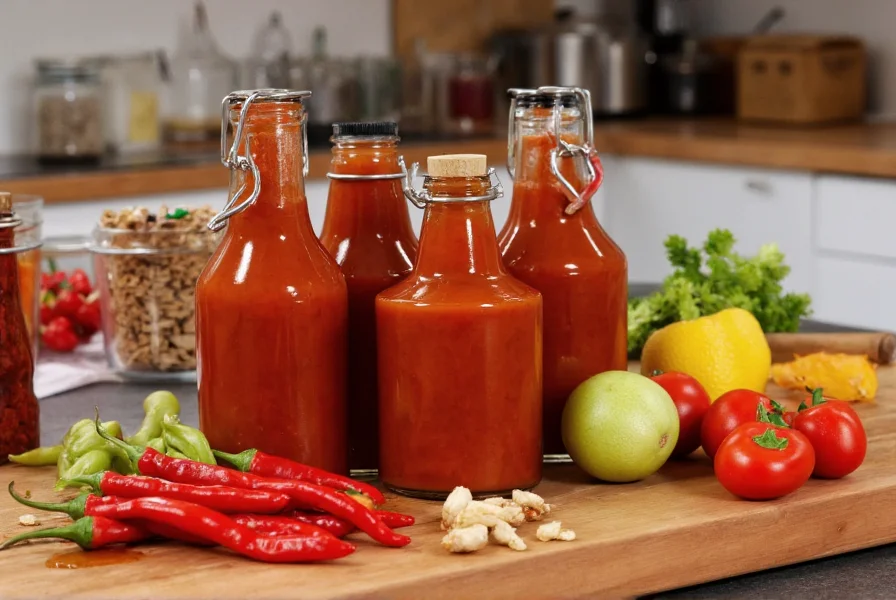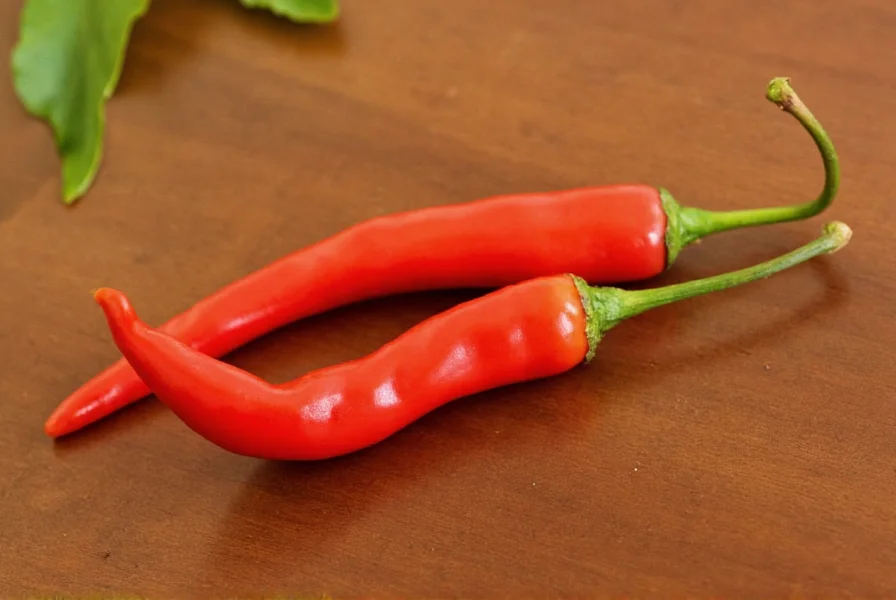Understanding the scorpion hot pepper begins with recognizing its position among the world's most fiery chilies. This potent pepper consistently ranks among the top five hottest peppers globally, with Scoville ratings that can exceed 2 million units—making it approximately 400 times hotter than a jalapeño. The distinctive curved tail resembling a scorpion's stinger gives this pepper its dramatic name and visual identity.
What Exactly Is a Scorpion Hot Pepper?
Scorpion peppers belong to the Capsicum chinense species, the same family as habaneros and ghost peppers. Two primary commercial varieties dominate the market: the Trinidad Moruga Scorpion and the Trinidad Scorpion 'Butch T'. Both originated in Trinidad and Tobago, where local growers selectively bred extremely hot peppers over generations.
Their unique appearance features a bumpy, lantern-shaped body with a characteristic curved appendage at the tip that resembles a scorpion's stinger. Mature peppers typically measure 1.5-2 inches in length and transition from green to vibrant red, yellow, or orange when fully ripe. This visual identification helps distinguish genuine scorpion peppers from less potent look-alikes.
| Pepper Variety | Scoville Heat Units | Compared to Jalapeño |
|---|---|---|
| Scorpion Hot Pepper | 1,200,000-2,000,000 SHU | 200-400x hotter |
| Ghost Pepper | 855,000-1,041,427 SHU | 100-140x hotter |
| Habanero | 100,000-350,000 SHU | 12-35x hotter |
| Jalapeño | 2,500-8,000 SHU | Baseline |
Flavor Profile Beyond the Heat
Despite its fearsome reputation, the scorpion hot pepper offers a complex flavor profile that many chili enthusiasts appreciate. Before the intense heat hits, you'll detect distinct tropical fruit notes—often described as mango, peach, or apricot—with subtle smoky undertones. This initial sweetness makes scorpion peppers valuable in Caribbean cuisine where they're used to add depth rather than just heat.
The heat progression follows a specific pattern: initial fruitiness, building warmth, then an intense burning sensation that peaks around 2-5 minutes after consumption and can last up to 30 minutes. Unlike some hot peppers that deliver immediate heat, scorpion peppers have a deceptive delayed reaction that often catches inexperienced eaters by surprise.
Scorpion Pepper vs Ghost Pepper: Understanding the Difference
Many home cooks confuse scorpion peppers with ghost peppers (Bhut Jolokia), but several key differences exist. While both rate among the world's hottest peppers, scorpion varieties typically exceed ghost peppers in maximum heat potential. The Trinidad Moruga Scorpion has been laboratory tested at over 2 million SHU, while ghost peppers max out around 1.04 million SHU.
Visually, scorpion peppers have a more rounded, lantern-like shape with the distinctive stinger tail, whereas ghost peppers appear more elongated and wrinkled. Flavor-wise, scorpion peppers offer more pronounced fruit notes compared to the smokier profile of ghost peppers. For those exploring scorpion pepper substitutes, understanding these differences helps select appropriate alternatives based on whether heat level or flavor profile matters more for your recipe.

Safe Handling Practices for Extreme Heat
Working with scorpion hot peppers requires serious precautions due to their extreme capsaicin concentration. Always wear nitrile gloves when handling—latex won't provide sufficient protection. Avoid touching your face, especially eyes, during preparation. Work in a well-ventilated area as the volatile oils can become airborne and cause respiratory irritation.
If you experience skin burns, remove gloves carefully and wash affected areas with soap and cold water. Milk, yogurt, or oil-based products can help neutralize capsaicin on skin. For eye exposure, flush immediately with cool water for 15 minutes and seek medical attention if irritation persists. Never use water alone to relieve mouth burn—dairy products containing casein work best to break down capsaicin.
Culinary Applications of Scorpion Peppers
Due to their intense heat, scorpion peppers should be used sparingly in cooking. The best approach for how to use scorpion peppers in cooking involves starting with tiny amounts—a small slice or even just scraping seeds—and gradually increasing to taste. They excel in small quantities in hot sauces, marinades, and Caribbean stews where their fruity notes can shine through.
When making hot sauce, many producers use scorpion peppers as a base but balance them with fruit juices or vinegars to create complex flavor profiles. For those exploring scorpion pepper recipes, consider starting with infused oils or vinegars rather than direct incorporation, as these methods provide more controlled heat distribution.
Growing Scorpion Peppers at Home
Cultivating scorpion peppers requires specific scorpion pepper growing conditions. These plants need 90-100 days to mature, prefer temperatures between 75-90°F (24-32°C), and require high humidity levels. Start seeds indoors 8-10 weeks before last frost, using a heat mat to maintain soil temperature around 85°F (29°C).
The plants grow 24-36 inches tall and benefit from support as they mature. Consistent watering is crucial—allow soil to dry slightly between waterings but avoid complete drying. When harvesting, use scissors rather than pulling peppers off to prevent plant damage. Remember that heat levels increase as peppers fully ripen to their final color.
Storage and Preservation Techniques
Proper storage extends the usability of your scorpion peppers. Fresh peppers keep for 2-3 weeks in the refrigerator's crisper drawer. For longer preservation, freeze whole peppers on a baking sheet before transferring to airtight containers—they'll remain usable for 6-12 months. Drying peppers in a food dehydrator (125°F/52°C for 12-24 hours) creates potent flakes that maintain heat for years when stored properly.
Many chili enthusiasts prefer making scorpion pepper-infused vinegars or oils, which capture the flavor while providing controlled heat delivery. Always label preserved products clearly with heat warnings to prevent accidental overuse.

Responsible Consumption Guidelines
Understanding how hot is scorpion pepper in practical terms is essential for safe enjoyment. Never consume large quantities—start with minuscule amounts to assess tolerance. The delayed heat response means you might not feel the full intensity for several minutes, tempting some to eat more before realizing the consequences.
People with sensitive stomachs, gastrointestinal conditions, or certain medical conditions should avoid extremely hot peppers altogether. When serving dishes containing scorpion peppers, always provide clear warnings and milder alternatives. Responsible use ensures that scorpion pepper culinary experiences remain enjoyable rather than overwhelming.
Frequently Asked Questions
How dangerous is the scorpion hot pepper?
While extremely hot, scorpion peppers aren't inherently dangerous when used responsibly. The primary risks involve temporary pain, skin irritation, and potential gastrointestinal distress. Serious health complications are rare but possible with excessive consumption, particularly for those with pre-existing conditions. Always handle with gloves and use in minute quantities.
What's the difference between Trinidad Moruga Scorpion and regular scorpion pepper?
The Trinidad Moruga Scorpion is a specific variety that typically reaches higher heat levels (1.8-2.0 million SHU) compared to the standard Trinidad Scorpion 'Butch T' (1.2-1.5 million SHU). Moruga Scorpions have a more rounded shape and slightly different flavor profile with pronounced fruit notes, while 'Butch T' varieties show more variation in heat and appearance.
Can you build tolerance to scorpion peppers?
Yes, regular consumption of hot peppers can build temporary tolerance through desensitization of pain receptors. However, this tolerance resets when consumption stops. Building tolerance should be done gradually, starting with milder peppers before progressing to scorpion varieties. Never force tolerance development as this can cause physical damage to mucous membranes.
What are safe substitutes for scorpion peppers?
For similar heat with less intensity, consider ghost peppers (Bhut Jolokia) or Reaper varieties. For flavor without extreme heat, habaneros provide comparable fruitiness at significantly lower Scoville levels. When substituting in recipes, start with 1/4 the amount of substitute pepper and adjust to taste, as heat levels vary considerably between varieties.
How do you neutralize scorpion pepper burn?
For skin exposure, wash with soap and cold water, then apply milk, yogurt, or oil-based products. For mouth burns, consume dairy products like milk or yogurt—avoid water which spreads capsaicin. For eye exposure, flush with cool water for 15 minutes and seek medical attention if irritation persists. Baking soda solutions can help neutralize capsaicin on surfaces.











 浙公网安备
33010002000092号
浙公网安备
33010002000092号 浙B2-20120091-4
浙B2-20120091-4